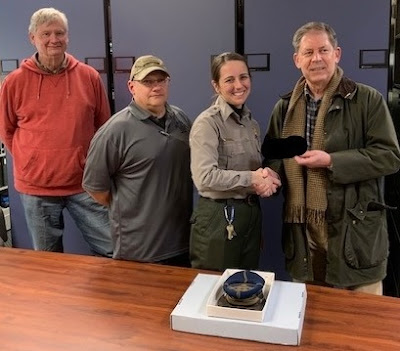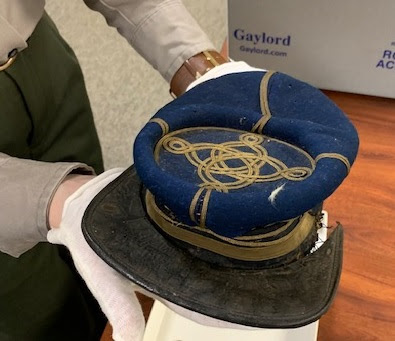 |
| Capt. George T. Burch's kepi after extensive treatment (NPS photo) |
The hat
belonged to Capt. George Tilley Burch of Company I, 29th Georgia
Infantry. In the years following his death in July 1864, the cap's
interior -- from its leather and lining to delicate silk -- had
deteriorated to the point of being a pile of fabric. Small holes perforated the
woolen exterior and the stitching connecting the brim to cap was loose,
allowing a partial separation.
Now it has
received some TLC.
The
artifact was sent a couple years back to the National Park Service’s Harpers Ferry Center. Museum
Conservation Services worked to stabilize the material and make some repairs
and corrections.
 |
| (NPS photo) |
“The sweatband and cardboard internal backing band were both humidified and reshaped, tears in the cardboard internal band were repaired, the sweatband was reattached using an edged lining of toned spun bond polyester, other sections were re-stitched and re-stabilized, and the visor was reattached and re-stabilized using the original stitching holes.”
The park near Atlanta received an $8,000 donation from the Artist Preservation Group to have the item – considered to be in poor condition -- sent off.
“Due to the generous support of the Artist Preservation
Group, Inc., this artifact will be able to continue to tell the story of this
individual soldier for current and future generations,” the park said in Friday’s
post, adding it plans to put it on display at some point.
 |
| Wear, damage in kepi's interior before conservation (NPS photo) |
The sash (below) has
been on display at the Kennesaw museum, while the kepi had long awaited
conservation.
 |
| (NPS photo of George T. Burch sash) |
Cummins’ late
brother, George Fisher Jr., a few years ago donated a portrait of the soldier
to the park, Corman told the Picket in an email this week. “Unfortunately, due to a backlog the
portrait has not been completely processed into the collection.”
Corman said the park eventually would like to display the kepi
at its visitors center buts plans have not been firmed up. It’s possible it
could be paired with a Confederate butternut kepi.
 |
| Amanda Corman, members of Artist Preservation Group, before hat sent off (NPS photo) |
"He
lingered four weeks, during which time his sufferings were frequently excruciating,
but the Christian grace which sustained him on that bed of languishing far
outshone his heroism on the battlefield," said this obituary, which noted the officer’s last words were,
“I am willing to die, I am willing to die.” He passed away on July 13.
According
to documents kept by the Gilder Lehrman Institute of American
History, Burch was a graduate of central Georgia’s Mercer College – the class
of 1861 had lost eight members in battle by summer 1864 -- joined the
Confederate army in Savannah in August or September 1861 and fought in
Mississippi and Georgia. He was elected captain in May 1862.
 |
| Another view of the kepi before treatment (NPS photo) |
“In that
fatal charge he was among the foremost and scorned to screen himself the hated
foe, preferring rather to face them bravely in death, rather than cower and
tremble before their approach,” the memoriam recounts. The
29th Infantry fought until war's end -- through the Atlanta
Campaign, Hood's winter operations in Tennessee and at the Battle of
Bentonville, N.C., in March 1865.
“In his
disposition he was most affectionate, gentle in his manner, firm in action,
incorrupt in principle, and pure in spirit," Burch's obituary reads. The
officer is buried
with family members in Newnan, about 40 miles southwest of
Atlanta.
Like other family members, Cummins hails from Newnan, but she has lived in Seattle for decades. Her father told her the portrait of Burch at left may have been painted posthumously, perhaps from a photograph.
Cummins said she does not know what the star on the lapel represents. (Portrait courtesy of Jenny Cummins)
She was
unaware of the work on the kepi until her daughter came across a February 2020
Civil War Picket article about it. Cummins said she in the past year has
donated George T. Burch’s diary to a historical society in Newnan.
“I am delighted they have done it and they are
taking care of it,” she said of the kepi conservation and preservation effort.
 |
| 29th Georgia marker at Chickamauga (Library of Congress) |

Thank you, Phil, for all you have done to make this known.
ReplyDelete